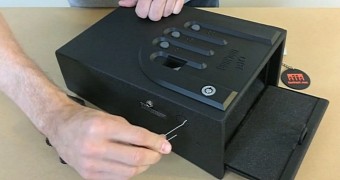As more people are buying firearms, handgun safes are becoming a common occurrence in US homes as the recommended method of keeping guns away from curious children or individuals that are not trained or authorized to handle them.
HandgunSafeResearch is a website that reviews some of these handgun safes and tries to hack them in one way or another.
Their most recent test subject was the GunVault GVB1000, a $340 (€310) handgun safe that features biometrics protection, meaning it mainly works via a fingerprint-based locking system.
Since any biometrics system needs electrical power to work, and in some cases, batteries may die or electrical power may be cut off to the safe, a secondary key-based lock system is also present.
This is smart engineering and is useful in cases where a robber cuts the electrical power to your house, and you need quick access to the gun. Unfortunately, as the team at HandgunSafeResearch has found, this secondary key-based lock system also adds an additional design flaw.
Wire inserted in the safe's vent holes opens the door
Because of the key-based locking system's positioning on the safe, the HandgunSafeResearch has discovered that an attacker could insert a wire through vent holes on the side of the safe and move the release mechanism enough to open the safe's door.
"Now I've done no damage to the electronics in here, no damage to the mechanical components of the locking mechanism, the fingerprint reader still works, the door still opens and closes, and if I take my paperclip with me I leave no indication to as how I gained access," the HandgunSafeResearch tester explained in their most recent video (embedded below).
Softpedia has contacted GunVault for its reaction to this video. Albeit, even without an official answer, we are inclining to the theory that the vent holes and the locking system positioning aren't just an accident, and that they were left so close to each other as a third method of opening the safe when the electronics are down and the key was lost.
UPDATE: A GunVault representative has told Softpedia the following:
"We have identify this problem with our safe designs. We are aware of this, however we have taken this into our safe Engineers to work on this. Unfortunately, all of our safes are designed the same way and even a replacement safe will run with into the same problem. I understand your concern, however we are doing our best to have this problem correct it."

 14 DAY TRIAL //
14 DAY TRIAL //